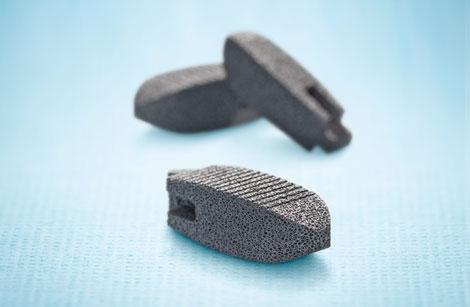Porous Metal Spine Implant Heals Bone
July 19, 2012

A highly porous metallic substance with characteristics similar to the spongy type of bone has been formed into a lumbar spine implant by Zimmer Holdings for use in the treatment of degenerative disc disease.
The company's new TM Ardis Interbody System is made of Zimmer's tantalum-based Trabecular Metal (TM) technology. The material has a structure, function, and physiology resembling those of cancellous, or trabecular, bone. This type of bone is softer than the other type, compact bone, and usually occurs inside vertebrae, near joints, and at the end of long bones.
The porosity and elasticity of Zimmer's TM material helps foster new bone growth between the implant and the patient's bone to speed healing. Zimmer already uses the material in its other products, made for use in the cervical spine in reconstructive orthopaedic applications, as well as in implants for the hips, knees, and extremities. The material has a history of several years of clinical success as an implant.

TM has a porosity of up to 80 percent, with a consistent and open pore structure that is created by a nano-textured strut architecture. The elemental tantalum that TM is based on is biologically inert and chemically stable, with a strength higher than titanium. Tantalum has both a high fatigue strength and a compressive modulus that lets it bend before it breaks. The low modulus of elasticity of the TM material gives it a flexibility similar to that of cancellous bone.
Zimmer designed the TM Ardis implant with a large porous surface area. This surface area provides space for a maximum amount of bony in-growth, and also helps distribute load more evenly. The implant allows isoelastic load sharing, so it doesn't need as much stress shielding. It is shaped anatomically to make it easier to insert in a disc, and comes in 40 different sizes. According to a press release, this is "the first application of a porous metal implant with an interbody indication for the lumbar spine in the US."
The Trabecular Metal material starts as an engineered polyurethane foam, which is then transformed into pure carbon by being chemically treated and pyrolized. The carbon can be machined or crushed, and its pores remain open. Vitreous carbon components are then placed in a reactor where thermal deposition takes place. Pure tantalum is heated to very high temperatures and vaporized, then tantalum molecules in vapor attach to the carbon during chemical vapor deposition, building the TM into net shapes. This process creates a nanotextured surface of pure tantalum that bone and soft tissue can grow onto.
Related posts:
About the Author(s)
You May Also Like

.jpg?width=300&auto=webp&quality=80&disable=upscale)

